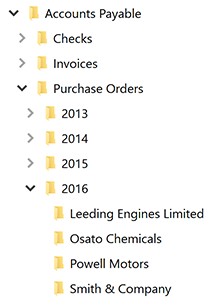The biggest pain people experience with paperwork is that it stands in the way of them completing their strategic business objectives. That's it, plan and simple.
Now let me explain.
Virtually every company operates in the same way. You have an event that triggers a reaction so that you can fulfill your business goals. The trigger event could be virtually anything:
- An invoice comes in for payment
- A new employee is hired
- A customer has an inquiry
- A patient is admitted into a hospital
- You get notice of an audit
- A new project begins
- Etc.
Your reaction to these events is what enables you to meet the goals for your role to fulfill the overall business objectives. The one common element of any reaction is the need for information. That information may be stored in your head, on paper, digitally, etc. and your ability to respond quickly, meet your goals and fulfill your promises rely on the accessibility of that information.
For most companies, accessing information in a timely manner can be a real chore. Some of the challenges include:
For most companies, accessing information in a timely manner can be a real chore. Some of the challenges include:
- The information is spread across multiple sources. Part of the file could be on paper, another part may be a digital file on your network, there could also be a number of emails relating to the trigger event, even legacy systems like microfilm/microfiche. To compound this disjointed filing system parts of it may be onsite and others stored offsite.
- Are you looking at the right version? After finding the relevant information are you sure it's the most recent/accurate? How many of us have come across a files on the network labelled "XYZ.docx" "XYZ - Final.docx" "XYZ - Rev1.docx" "XYZ - Final - Rev1.docx"? Having access to information quickly is only helpful if the information is accurate.
- The flow of information is ineffective. A trigger event usually creates a reaction that involves multiple people. Take for instance an invoice that needs payment. You have someone handling the mail, someone doing a preliminary match up of the invoice, receiving documents and purchase order, a manager who needs to review and approve it and a controller/CFO who needs to issue payment. The flow of that information in an effective manner can be the difference between taking advantage of early payment discounts or being charged late payment fees.
- Information is stored in a way that's useful for some but not for all. Using a file folder structure on your network drive as a way to manage your documents is a very linear approach to filing. Let's say we have an Accounts Payable structure like the one below. It's a well laid out system for people looking for a specific invoice or purchase order, but what if your role requires more analytics? What if you wanted to find all invoices over $5,000? What if you wanted to match the purchase order, invoice and check for a specific order? All of sudden, this structure isn't overly helpful.

A proper document management system is the key to addressing all of this and much more. With a professional DMS you can:
- Consolidate all your records into one place by scanning hard copy files, importing electronic files like emails and other office documents, you can even virtually print records into the system instead of generating hard copies.
- Control and track versions. You can keep a complete history of all the changes made to a specific document, who made the changes, when they were made, etc. so you're always been presented with the most recent version.
- Process work electronically. Workflows can be setup to move documents along pre-defined or adhoc processes. For example, an invoice could be scanned in by the mail room, it could automatically be routed to the manager for approval while simultaneously displaying the purchase order and receiving documents for verification and finally sent to the controller/CFO who can decide to pay the invoice immediately for early payment discounts or delay payment based on credit terms to better control cash-flow.
- Define custom filing systems to meet everyone's needs. Unlike network file structures, a DMS isn't usually limited to a linear file hierarchy. Users can customize search fields based on the needs of everyone. Accounts payable documents could be search on any combination of fields such as PO number, invoice number, invoice date, vendor, total, etc.
So as I mentioned at the start, the biggest pain people experience with paperwork is that it stands in the way of them completing their strategic business objectives because it’s an ineffective way to manage, share and access information.

